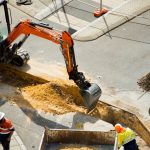The Different Demolition Methods
Are you looking to demolish an old building to build your dream home? Would you like to get rid of an outdated structure on your property to build a swimming pool?
Demolition methods can vary considerably depending on the size and type of project in question.
Find out about the different ways to demolish a building and how professionals decide which demolition method to use.
Factors to consider when choosing a demolition method
We recommend getting in touch with a professional building demolition company before embarking on a demolition project yourself. Professional demolition experts are the only people qualified enough to advise you on the most suitable demolition method for your project.
To choose the best course of action, the professional in charge of your demolition project will consider the following factors:
- The location of the building to be demolished (inside or outside)
- The height of the building
- Its structure and shape (industrial buildings, schools, houses)
- The materials it is made out of (concrete, reinforced concrete, metal)
- Whether there is a frame structure present
- The surroundings (demolition of a house with a party wall, possible constraints in terms of noise, vibrations, and dust accumulation)
Once these factors have been considered, the project manager will select which of the following methods is best suited to your project:
- Manual demolition: dismantling or undermining
- Mechanical demolition: either the bucket and hook method using a demolition shovel, the bulldozer method, or the demolition clamp method
- Cutting and sawing the structure
- Placing explosives
- Expansion demolition (hydraulic spreaders, hydraulic cylinders or expanding agents)
Dismantling or deconstruction
The dismantling method is a manual operation which consists of destroying a building by knocking down its highest parts first. This technique is used to reduce the height of a construction without altering its foundations (commonly used for partial restorations).
It is also the ideal method if you want to demolish a building while reducing collateral damage. It protects surrounding homes and buildings from being hit by falling stones and rubble.
It is mainly used for the following types of projects:
- Church restoration
- City wall demolition
- Tower demolition
Undermining
Unlike dismantling, undermining is demolishing a structure from the bottom up. To do this, demolition professionals “undermine the bases”, i.e. they destroy the foundations of the building by digging underneath it. They place wedges and props on the load-bearing structures to ensure safety during the project.
Once the work is completed, the wedges and props are destroyed (or set on fire if they are wooden wedges) so that the construction collapses in one go.
Undermining is mainly used to demolish a turret or a chimney. However, this technique is not recommended when there are houses in the vicinity.
The bulldozer method
Bulldozers are ideal for demolishing concrete or brick buildings. These machines are equipped with a blade that pushes materials, causing them to fall. The main advantage of the bulldozer method is that the leftover rubble can be loaded directly into the skip. This facilitates waste disposal management on the construction site.
Note, however, that this technique only works for buildings less than 3 meters high. It is very important to respect this rule to avoid fatal injuries.
The bucket and hook method
This demolition technique requires a hydraulic excavator. This machine can be used to tear down a structure by pushing (putting weight on the structure), pulling (tugging at materials) or by impact (knocking on the building to shake its foundations).
The bucket excavator is generally used to destroy low structures that have little resistance to traction. It is the ideal tool for demolishing load-bearing walls and buildings made of cinder blocks or bricks.
Hook buckets are mainly used for secondary demolitions. In this case, the shears are used to break up blocks that have fallen to the ground or to separate scrap metal from concrete.
Hydraulic hammer method
Installed on the jaws of excavators, hydraulic hammers are used to crush concrete pieces. These machines are often used to destroy concrete or steel structures, to cut through steel sections or to crush and split materials.
Cutting and sawing
Demolition by cutting is a method that does not generate any shock or vibrations. It is used to precisely outline the parts that need to be demolished. Cutting can be done by hydro demolition (projection of a high voltage water jet), sawing or with diamond blades.
Explosive demolition
Blasting is the safest and most cost-effective way to demolish a building over 20 meters high. However, this method requires a great deal of technical know-how and a thorough knowledge of how structures and buildings work.
The amount of charge and the explosives required depend on the structure of the building.
Bursting
Bursting is the recommended solution for partial demolition projects. It is based on the principle of expansion and dislocation. This type of demolition can be carried out using hydraulic spreaders, hydraulic cylinders or expanding agents. The main advantage of expansion demolition is that it does not generate dust or vibrations.
Contact Excavation Chanthier to complete your demolition project!
As you have read throughout this article, demolishing a building is a process that requires careful planning and execution. Each demolition method has its advantages and disadvantages that should be considered before beginning a demolition project.
Do you live in the Greater Montreal area and wish to undertake demolition work?
At Excavation Chanthier, all our demolition projects are carefully planned and executed. Whether you need assistance with demolishing a house, demolishing a garage, or the remains of a building after a disaster, we guarantee our customers a professional and fast service.
To discuss your demolition project with our experts, contact us today!







